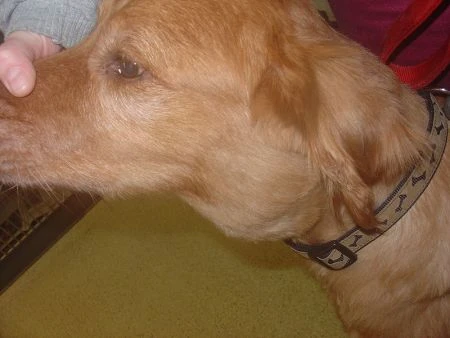Bladder Cancer in Dogs – A complete guide to the causes & symptoms

A Complete Guide to Bladder Cancer in Dogs…

Bladder cancer in dogs is a very serious condition which can lead to a variety of symptoms including urinary problems (problems when attempting to urinate) and urinary tract infections…of course the symptoms can be far more serious so we have included a list of some of the symptoms that you should look out for.
There are many factors that can be linked to bladder cancer in dogs including…
Medications – There are certain carcinogenic in some medications used on dogs including the drug Cyclophosphamide which has a chemical called Acroleinis which is now known to cause canine bladder cancer.
Chemicals – You need to be careful with some chemicals that you use in the House, on your dog and in your garden. Some evidence is emerging that some insecticides, mosquito sprays and even tick dips can increase the likelihood of bladder cancer in dogs.
Genetics – Canine bladder cancer is actually more common in certain breeds including… Wire hair Fox Terriers, Scottish Terriers, Airedale Terriers, Shetland Sheepdogs, Beagles and West highland terriers.
Gender – Gender can also be a major factor in the risk of your dog getting the disease. Did you know that female dogs are actually far more likely to get the disease especially if they weigh over 22 pounds.

Signs & Symptoms of Bladder Cancer in Dogs.
It is important that if you notice any lumps and bumps on your pooch that you get them checked out by the Vet. Listed below are just some of the symptoms that can be seen with this condition.
- Urinary problems – including incontinence
- Blood may show in the urine
- Your dog may suffer from Dysuria – this is when they have pain urinating.
- Your dog may suffer from Hermaturia this is when the urine appears brown due to a presence of blood cells in the urine.
- Your dog may have urinary tract infections that seem to return on a regular basis.
- You may start to notice that your dog is peeing more often but when they actually go they only pee a small amount, this is known as Pollakiuria.
- Another symptom is when your dog has a poor response to antibiotics after experiencing a urinary tract infection.
Treatment – Your dog’s vet may opt for conventional treatment including chemotherapy which may involve the vet using drugs including Mitoxantrone, Adriamycin, Carboplatin and/or Cisplatin which will fight the tumors.
A new drug has started being used to battle cancer tumors and is called Piroxicam (Feldene). Radiation may also be used but this does have some nasty side effects including fibrosis. Surgery may also be used on small clumps of the bladder but only in the upper part as Cancer in the neck is inoperable.
What chance does my Dog have….?
- The most common form of bladder cancer and malignant tumors are called transitional cell carcinomas which are referred to as TCC – This tumor normally affects the neck of the bladder. You can see a similar tumor in the picture just above on the left of the page.
- Unfortunately the prognosis for dogs that develop the disease is bad. About half of dogs that are diagnosed with this condition are diagnosed too late and the disease has already spread to the lymph nodes, lumbar vertebrae and pelvis.
You will need to get your dog checked regularly and watch out for tell tale symptoms such as drinking too much and other symptoms that we have listed on this page as catching the disease at the earliest possible stage is very important.
We have also listed some more common symptoms on the right of the page.
If you found this page useful you may also be interested in our page on canine lung Cancer too.
References: Bordwell, S. 1994. The American Animal Hospital Association Encyclopedia of Dog Health and Care. Quill. New York.
Did you know…?

1. Cancer cells are able to reproduce rapidly and it doesn’t take long for them to attack and destroy healthy cells which enables the disease to metastasize (spread). The cancerous cells then travel around the body spreading the disease.
2. Abnormal cell growth and development is able to manifest itself in two ways: by clustering in the affected dog’s blood which is called Leukemia or through rapididly growing growths which are called tumors.
3. The most common types of tumors to affect dogs are skin tumors and tumors that affect the mammary glands. It is estimated that 50% of all mammary gland tumors are malignant.
4. Tumors tend to affect dogs more than any other animal. As previously mentioned the two most common types of tumors to affect dogs are mammary and lipomas. A mammary gland tumor tends to appear as small hard lumps under the skin. They can lead to bleeding and may become ulcerated.
5. Mammary tumors and Lipomas are able to grow anywhere on the bed where there is connective tissues. The lumps tend to feel as of they are floating beneath the skin. A tumor can vary in size from a few inches in length to as long as ten inches in length.
Mammary tumors tend to be more common in females that have not been neutered.
Classic Signs of Cancer…
There are many symptoms associated with the disease but belowe we have listed just a few of the more common signs…
1. Bumps and growths that increase in size.
2. Wounds that take time to heal or don’t heal at all.
3. Your dog may start to bleed from cavities.
4. Your dog may walk with an unusual gait.
5. The affected dog may have a foul odour.
6. There maybe paim when the affected dog eats or drinks.
7. The tumors may cause an obstruction that makes breathing, urinating and defecating painful.
Take a look at the Youtube video below for more information on canine bladder cancer.





